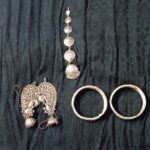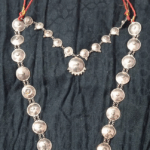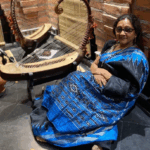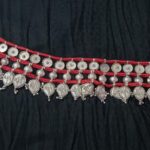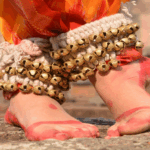ODISSI DANCE
 On the eastern coast of central India is the state of Orissa. It is an area of many cultures. At various points in its history, several religious and philosophies have swept through the state. The people of Orissa were influenced by many faiths. Each of the religion that prevailed in the land has built monuments to worship various Gods. As a result, Orissa is studded with many old caves and temples. Early among these, are the Jain cave temples of the 2nd century AD. These are called the Ranigumpha caves. The Tantric philosophy of the Shavis also had a strong impact on the culture and arts of the area. The Shiv temples in Orissa have numerous intricately carved images of Nataraj in dancing postures. Following that, in the 7th century AD, Mahyana Buddhism had a significant impact on Orissa, and in 9th century AD, Shankaracharya, a Vedantic philosopher, came to Orissa. Both Vishnu and Shiv were worshipped in this state. However, the main deity of people in Orissa is Lord Jagannath. His main temple is situated in Puri. This temple was built by King Chodaganga. He and other kings, who ruled Orissa in 10th century, were culturally very rich. They themselves were titled as Nritya Kesaris. So, the dance and music of Orissa have been influenced by over fifteen religions and cultures.
On the eastern coast of central India is the state of Orissa. It is an area of many cultures. At various points in its history, several religious and philosophies have swept through the state. The people of Orissa were influenced by many faiths. Each of the religion that prevailed in the land has built monuments to worship various Gods. As a result, Orissa is studded with many old caves and temples. Early among these, are the Jain cave temples of the 2nd century AD. These are called the Ranigumpha caves. The Tantric philosophy of the Shavis also had a strong impact on the culture and arts of the area. The Shiv temples in Orissa have numerous intricately carved images of Nataraj in dancing postures. Following that, in the 7th century AD, Mahyana Buddhism had a significant impact on Orissa, and in 9th century AD, Shankaracharya, a Vedantic philosopher, came to Orissa. Both Vishnu and Shiv were worshipped in this state. However, the main deity of people in Orissa is Lord Jagannath. His main temple is situated in Puri. This temple was built by King Chodaganga. He and other kings, who ruled Orissa in 10th century, were culturally very rich. They themselves were titled as Nritya Kesaris. So, the dance and music of Orissa have been influenced by over fifteen religions and cultures.
The local people believe that Shiv and his son Ganesh taught dance to a beautiful apsara named Manirabha. They also believe that sage Bharat taught the dance to a sage named Attahas who then taught the dance to the Maharis or Devdasis, the temple dancers. At that time, dancers were part of the every-day ceremonies of the temple. Along with them, many singers and instrumentalists were also employed by the temple. They were allowed to perform only the verses from Gita-Govind in front of the deity.
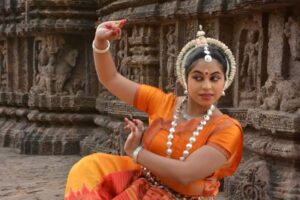 There were three kinds of dancers in Orissa. The first among them were Maharis who danced in the temples. Mahari dance is the mother of classical Odissi dance and is an important dance genre in Orissa. Mahari dance has been a component of the daily rituals at the Jagannath temple in Puri since the time of the Ganga monarchs of Utkala, and is nearly a thousand years old. Maharis were revered as cultural icons who drew religious and royal support and were credited with inventing the classical dance genre, Odissi. As a Devadasi’s property had to be inherited by a biological or adopted daughter to continue the lineage, these women had more socio-economic autonomy and access to the public arena than most marital women in the Indian empire. Only they were permitted into the inner shrine to be before the deity.
There were three kinds of dancers in Orissa. The first among them were Maharis who danced in the temples. Mahari dance is the mother of classical Odissi dance and is an important dance genre in Orissa. Mahari dance has been a component of the daily rituals at the Jagannath temple in Puri since the time of the Ganga monarchs of Utkala, and is nearly a thousand years old. Maharis were revered as cultural icons who drew religious and royal support and were credited with inventing the classical dance genre, Odissi. As a Devadasi’s property had to be inherited by a biological or adopted daughter to continue the lineage, these women had more socio-economic autonomy and access to the public arena than most marital women in the Indian empire. Only they were permitted into the inner shrine to be before the deity.
The second were the Nachunis who danced in the royal court, and the third were the Gotipuas who performed in front of the common people.
Interestingly, the gotipuas, were little boys who were trained in gymnastics in akhadas and could do difficult gymnastic poses. So, they were dressed as girls. Rich landlords supported the different groups of gotipuas and they travelled all over the state in jatra parties. A jatra party is a troupe of performers who went from one place to another for entertaining people.
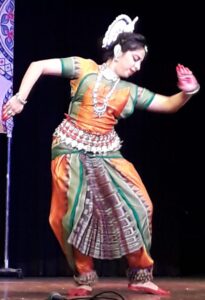 But the maharis, who danced in the temple, faded out and by 19th century and gradually the nachunis also disappeared. It was the time when India was struggling for its independence from the British who did not appreciate these customs. India was also seeking progress and looking for a more universal education pattern. It led to the intolerance for old systems and those that held back society, especially women. In the middle of all this, the gotipua community had survived, and it was from this community that the Odissi as a dance form returned. Although it is rare to see the original gotipua dance now, the style we do get to see and recognize as Odissi is based on it.
But the maharis, who danced in the temple, faded out and by 19th century and gradually the nachunis also disappeared. It was the time when India was struggling for its independence from the British who did not appreciate these customs. India was also seeking progress and looking for a more universal education pattern. It led to the intolerance for old systems and those that held back society, especially women. In the middle of all this, the gotipua community had survived, and it was from this community that the Odissi as a dance form returned. Although it is rare to see the original gotipua dance now, the style we do get to see and recognize as Odissi is based on it.
The people who revived the dying art of Odissi put it together by studying the sculptures carved on the walls of the temples in Orissa, old texts like Abhinaya Chandrika and the technique used by the little gotipua boys. Odissi is a very lyrical, ‘sculpturesque’ dance style. The postures in Odissi are pictures that convey meaning. The torso movement is unique to this form, and three bodyline bends are a sign of elegance. The basic chowka position is square in shape and a half-sitting position that the dancer uses all the time. Sometimes the movements of the dancer look like waves of water. Such special movements give the style its lyrical quality.
The instruments used in Odissi are mardala-a drum, the manjra or crymbals, the violin and flute. The dancer wears typical Oriya saris and beautiful silver jewellery.
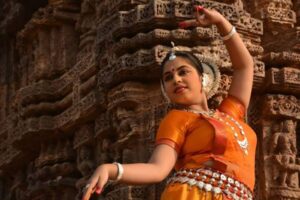 The Mangalacharan, which is generally the first piece danced at an Odissi dance concert, is the first item in the traditional Odissi repertory. The Mangalacharan is a Hindu pantheon invocation dance performed to evoke a specific god or goddess. Mancha pravesh (entering the stage), pushpanjali (flower offering), bhumipranam (paying homage to the earth), vandana (prayer to a deity), sabhapranam (jagarannritya + trikhandipranam [paying respect to god, instructors, and rasikas]) are all part of the mangalacharan (auspicious ceremonial).
The Mangalacharan, which is generally the first piece danced at an Odissi dance concert, is the first item in the traditional Odissi repertory. The Mangalacharan is a Hindu pantheon invocation dance performed to evoke a specific god or goddess. Mancha pravesh (entering the stage), pushpanjali (flower offering), bhumipranam (paying homage to the earth), vandana (prayer to a deity), sabhapranam (jagarannritya + trikhandipranam [paying respect to god, instructors, and rasikas]) are all part of the mangalacharan (auspicious ceremonial).
It establishes the core physical grammar of the dance drawn from sculptures and gotipua movements, with bhangis, belis, and arasas (postures, movements, and short dance phrases), supported by ukutas (rhythmic phrases), and a repeated musical refrain; batu/sthai (enduring/permanent/steady) is in the category of Nritta (abstract or pure dance).
Pallavi (expanding/blossoming) is an abstract dance in which the beat, music, and dancing are enhanced and expanded.
Sanskrit and Odia literature are interpreted through dance in abhinaya (to carry forward/dramatic portrayal for the stage). The Gita-Govinda and poetry by sixteenth–eighteenth-century Odia Bhakti poets such as UpendraBhanja, Banamali Das, BaladevRath, and others are among them.
The last dance, moksha (freedom), is performed to the beat of drums, with a focus on rhythmic patterns and speed. The route from mangalacharan to moksha is infinitely repetitive but can be different each time it is danced. Dancers can modify their repertory to the needs of the performance. For example, shorter programmes may necessitate the omission of one or more elements, whilst a longer programme may necessitate the presentation of two pallavis or a saabhinayapallavi (abhinaya combined with pure dance).
After getting to know about this beautiful form of a classical dance we could not stop ourselves from being part of this culture and art form. We started learning Odissi Nritya from our Guru Smt. Jyoti Shrivastava. We, Hegde sisters, have been the disciples of Smt. Jyoti Shrivastava and have adapted this Classiscal Dance form for the past 17 years. Under the guidance of our Guru, we have won many medals, prizes and awards. We have also had opportunities to perform at National Level Dance Festivals.
Nikita V Hegde Noida

